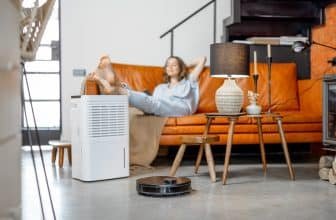Best Air Purifiers for Cigarette Smoke: Top Models for Clean Air in 2024
Cigarette smoke can significantly affect indoor air quality, making spaces uncomfortable and unhealthy. To tackle this, the best air purifiers for cigarette smoke use advanced filters to remove harmful particles and odors. These devices improve the air you breathe by using technologies like True HEPA filters and activated carbon filters. Finding the right air purifier can make all the difference in maintaining a cleaner, healthier living environment.
Several top-rated air purifiers are designed specifically to combat smoke. For instance, the Levoit Core 600S Smart Air Purifier is noted for its high performance, while the Coway Airmega AP-1512HH is highly recommended for its efficiency and extra features. These devices reduce not only smoke but also other airborne pollutants, ensuring a significant improvement in air quality.
Choosing the right air purifier involves considering several key features. Look for units with True HEPA filters and activated carbon to handle both particulate matter and odors from smoke. Models like the Levoit Core 300 offer affordability without sacrificing quality. Proper maintenance is crucial to ensure optimal performance and longevity of your air purifier.
Key Takeaways: Best Air Purifiers for Cigarette Smoke
- Advanced filters are essential for removing smoke particles and odors.
- Top models include Levoit Core 600S and Coway Airmega AP-1512HH.
- Regular maintenance ensures the longevity and efficiency of air purifiers.
Understanding Air Purifiers and Their Significance
Air purifiers play a crucial role in improving air quality by removing pollutants and allergens from indoor environments. They use various types of filters to capture particles and help reduce smoke, dust, and odors.
Types of Air Purifiers
Air purifiers come in several types, each with its own strengths. HEPA filters are popular for trapping tiny particles like dust and pollen. These filters can remove up to 99.97% of airborne particles as small as 0.3 microns. Activated carbon filters are effective in removing odors and gaseous pollutants by trapping chemical vapors and fumes. Some air purifiers combine HEPA and activated carbon filters for better performance. Pre-filters are used to capture larger particles before they reach the main filter, prolonging the life of HEPA or activated carbon filters.
How Air Purifiers Work
Air purifiers work by drawing in air and passing it through filters to remove contaminants. The basic process includes a fan that pulls air into the purifier. The air then passes through the pre-filter, which captures larger particles like dust and hair. Next, it goes through the HEPA filter, which traps fine particles such as smoke, pollen, and mold spores. Finally, the air passes through an activated carbon filter, which adsorbs chemical pollutants and odors. Clean air is then circulated back into the room, significantly improving air quality.
The Importance of Air Quality
Maintaining good air quality is essential for health and comfort. Poor air quality can lead to respiratory issues, allergies, and other health problems. Using air purifiers can reduce exposure to harmful pollutants like cigarette smoke, which contains many toxic chemicals. For individuals with asthma or allergies, air purifiers can make a significant difference by reducing airborne allergens. Improved air quality can also enhance overall well-being and productivity. Investing in a reliable air purifier can help maintain a healthier indoor environment for everyone.
Key Features to Consider When Choosing an Air Purifier
When selecting an air purifier for cigarette smoke, it’s crucial to consider factors like filter effectiveness, room coverage, noise level, and additional features. These elements ensure the purifier meets your specific needs for quality air filtration.
Filter Types and Performance
Air purifiers typically use HEPA filters and activated carbon filters to remove harmful particles from the air.
- HEPA filters are essential as they capture particles as small as 0.3 microns. This includes dust, pollen, and smoke particles.
- Activated carbon filters are also important since they absorb volatile organic compounds (VOCs), odors, and gases from cigarette smoke.
Filter replacement frequency and cost are important considerations too. Regular replacements ensure maximum efficiency.
Room Coverage and CADR Rating
The Clean Air Delivery Rate (CADR) measures how effectively an air purifier cleans the air within a certain room size.
- It’s important to match the CADR rating with your room size to ensure adequate coverage.
- For example, a purifier with a high CADR rating is better suited for larger rooms.
Knowing the exact coverage area helps in choosing an air purifier that can handle your specific needs and maintain air quality throughout the space.
Noise Levels and Energy Efficiency
Noise levels can significantly impact comfort, especially in bedrooms or workspaces.
- Look for air purifiers with a low noise level setting, especially during the night.
- Check for units that offer a quiet mode or have a decibel rating of around 30-50 dB for quieter operation.
Energy efficiency is another important factor. Choose models with an Energy Star rating to save on electricity bills while ensuring the purifier runs effectively.
Additional Features and Usability
Modern air purifiers offer various additional features that enhance usability and performance.
- Auto mode adjusts the purifier settings based on air quality, which can be very convenient.
- Look for units with a user-friendly interface, remote control, and smartphone compatibility for easier operation.
Also, features like filter replacement indicators help maintain efficiency by reminding you when it’s time to change filters.
Evaluating the Best Air Purifiers for Smoke
Choosing the right air purifier for smoke can depend on factors like efficiency, cost, and advanced features. Here are some top picks, budget-friendly options, and high-tech models to consider.
Top Picks for Smoke Filtration
For smoke filtration, some models stand out in performance and features. The Blue Pure 311i+ Max is a favorite, with excellent all-purpose air purification and superior capability to capture smoke particles. It uses both a true HEPA filter and an activated carbon filter to eliminate smoke and odors effectively.
Another excellent choice is the Coway Airmega AP-1512HH Mighty, known for its powerful filtration system and auto mode that adjusts the fan speed according to air quality. It’s highly rated for larger rooms and is effective against cigarette smoke and wildfire smoke alike.
The Levoit Core 600S Smart Air Purifier is another strong contender. It features a true HEPA filter with an advanced air quality sensor, ensuring the air is consistently clean.
Budget-Friendly Options
For those looking for more affordable solutions, the Levoit Core 300 stands out. Priced around $99.99, it is compact and designed for smaller spaces. Despite its small size, it still features a true HEPA filter, capable of capturing a high percentage of smoke particles.
Another budget option is the LEVOIT Compact True HEPA Air Purifier, available for around $90. It is effective in reducing smoke and odor in small to medium-sized rooms and is easy to move around as needed.
For those who prefer a lower upfront cost but still need efficient smoke filtration, these budget options offer a good balance between cost and performance. They still provide essential features like HEPA filtration and activated carbon filters without breaking the bank.
Advanced Models with Superior Technology
For those willing to invest in advanced technology, the Dyson Purifier Cool is a premium choice. It combines air purification with a cooling fan, making it multifunctional. This model also features a formaldehyde filter, which is particularly useful for those sensitive to multiple pollutants.
Another high-tech option is the Molekule Air Mini+. This model uses PECO (Photo Electrochemical Oxidation) technology to destroy pollutants at a molecular level, providing a deep clean beyond traditional HEPA filters. It’s ideal for those who want the latest technology in air purification.
Additionally, the Coway Airmega AP-1512HH Mighty is again worth mentioning as it balances advanced features like an air quality indicator with strong filtration capabilities. This model continuously monitors air quality and adjusts settings automatically to maintain clean air.
These advanced models come with higher price tags, but their innovative features, such as smart sensors and enhanced filters, offer top-tier smoke filtration and convenience.
Maintaining Your Air Purifier for Optimum Performance

Proper maintenance ensures that your air purifier works effectively, handling cigarette smoke and other pollutants. Key steps include cleaning and replacing filters, understanding device indicators, and performing routine checks.
Cleaning and Replacing Filters
Regularly cleaning and replacing filters is crucial. Most air purifiers come with a combination of filters including a washable pre-filter, an activated carbon filter, and HEPA filters. The washable pre-filter should be rinsed monthly to remove larger particles and dust.
Activated carbon filters and HEPA filters need periodic replacements. Depending on the manufacturer’s guidelines, HEPA filters generally need to be replaced every 6 to 12 months, while activated carbon filters need replacement every 3 to 6 months. Regular filter maintenance is essential to keep your air purifier performing at its best against cigarette smoke.
Understanding the Indicators and Sensors
Modern air purifiers are equipped with indicators and sensors to help with maintenance. Air quality indicators, usually in the form of color-coded lights, show the current air condition. Green typically means good air quality, while red may indicate poor air quality.
Some advanced models come with particle counters that give a more specific reading of pollutant levels. It’s important to pay attention to these indicators and take action when necessary, such as increasing the fan speed or cleaning the filters. Ignoring these signals can lead to decreased performance and efficiency.
Routine Checks and Best Practices
Consistent routine checks are vital. Check the air purifier’s fan blades for dust build-up. Clean them if necessary to prevent motor strain. Ensure the purifier is placed in an appropriate spot, away from walls and off the floor to allow unobstructed airflow.
It’s also wise to read consumer reports for your model to understand common maintenance tips and longevity feedback. Regular upkeep not only prolongs the life of your air purifier but also ensures it continues to effectively filter out cigarette smoke and other pollutants.
Health Benefits and Considerations
Using air purifiers to reduce cigarette smoke can greatly improve indoor air quality. These devices help minimize exposure to harmful pollutants and allergens, benefiting respiratory health and addressing specific needs for pet owners.
Impact on Respiratory Health and Allergies
Air purifiers can significantly improve respiratory health, especially for individuals with asthma and allergies. Cigarette smoke contains fine particles, such as PM2.5 and PM10, which can be detrimental to lung health.
By filtering out these particulate matters, air purifiers can reduce coughing and breathing difficulties. According to the Centers for Disease Control and Prevention (CDC), minimizing exposure to pollutants like volatile organic compounds (VOCs) and tobacco smoke can decrease the risk of respiratory infections.
Another advantage is the removal of allergens. People prone to allergies can benefit from reduced indoor allergens like dust and pet dander. This creates a cleaner environment, fostering better overall respiratory health.
Considerations for Pet Owners
Pet owners often face issues like pet dander and odors, which can worsen indoor air quality. Air purifiers specially designed for smoke can also address these concerns, making them ideal for households with pets.
Devices with HEPA filters can capture fine particles and pet dander, preventing them from circulating in the air. This helps reduce allergy symptoms and asthma triggers. Some air purifiers also come with carbon filters to absorb odors from pets and smoke.
These features contribute to a fresher indoor environment, making life more comfortable for both pets and their owners.
Reducing Exposure to Harmful Pollutants
Cigarette smoke is a complex mixture of chemicals that includes harmful pollutants like VOCs, particulate matter (PM2.5, PM10), and other toxic substances. Using an air purifier can reduce exposure to these harmful particles.
Devices with high Clean Air Delivery Rate (CADR) ratings are effective at removing fine particles and improving air quality. The Environmental Protection Agency (EPA) highlights the importance of clean indoor air to reduce health risks associated with smoke and VOCs.
Reducing exposure to these pollutants can lower the risk of respiratory diseases, headaches, and other health problems related to poor air quality. This makes air purifiers a valuable tool in maintaining a healthier living environment.
Frequently Asked Questions
Choosing the best air purifier for cigarette smoke involves understanding the effectiveness of different technologies, identifying essential features for your needs, and selecting products recommended by experts.
How effective are HEPA air purifiers at removing cigarette smoke?
HEPA air purifiers are very effective at removing fine particles from cigarette smoke. They can capture up to 99.97% of particles as small as 0.3 microns. This includes smoke, dust, and allergens.
What features to look for in an air purifier specifically for large rooms affected by cigarette smoke?
For large rooms, look for a high Clean Air Delivery Rate (CADR) and coverage area. Also, consider an air purifier with activated carbon filters to remove smoke odors. It’s important that the unit has a powerful fan to circulate air efficiently.
Which air purifier brands are recommended by consumer reports for cigarette smoke eradication?
Brands such as Blueair, Levoit, and Medify are frequently recommended. The Blue Pure 311i+ and Levoit Core 600S are noted for their effectiveness.
Are there any air purifiers capable of eliminating the smell of cigarette smoke?
Yes, air purifiers with activated carbon filters are effective at removing the smell of cigarette smoke. Bissell air220 and Blueair Classic 680i are good options to consider.
How do air purifiers compare with cigarette smoke filters and smoke removal machines?
Air purifiers are generally more effective because they combine HEPA and activated carbon filters to remove both smoke particles and odors. Cigarette smoke filters and smoke removal machines might not be as effective at handling both.
Can secondhand smoke be effectively filtered out with home air purifiers?
Air purifiers can help reduce secondhand smoke exposure. HEPA filters remove harmful particles, while activated carbon filters help with odors. They can considerably improve indoor air quality, but they may not eliminate all contaminants entirely.
best air purifiers
My name is Philipp Walz, editor at best-air-purifiers.com, and I’m truly passionate about creating healthier living spaces through smart, effective air purification. For me, air purifiers aren’t just appliances – they’re a quiet revolution in how we breathe, live, and feel at home. Clean air means better sleep, clearer thinking, and fewer allergies. It’s about giving our bodies what they need most: pure, fresh air. I’ve experienced firsthand how the right air purifier can transform a space and improve well-being – and I’m here to help others discover that difference. Because when you breathe better, you live better.






